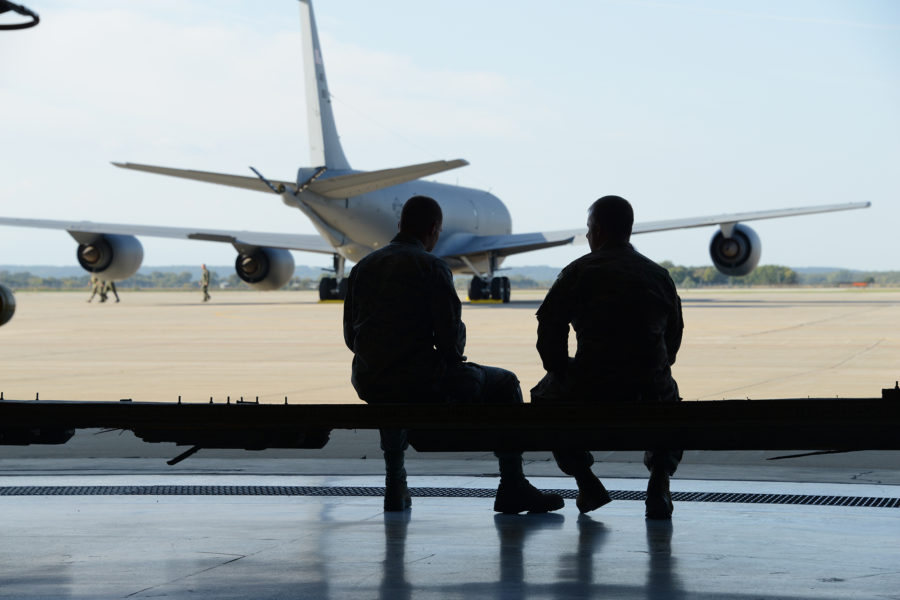Nearly 500 military personnel took their own lives in 2019, and most of those were young, enlisted white men, according to the Pentagon’s annual suicide report, released Oct. 1. Guns played a role in most of those incidents.
The most recent statistics show about 50 fewer service members died by suicide in 2019 than in 2018, as the armed forces have stressed the importance of mental health and connectedness. The suicide rate among Active-duty personnel has remained about the same over the past two years, while the National Guard and Reserve’s rates have dipped since 2017.
“We in the department must do all we can to address and prevent these tragedies,” Defense Suicide Prevention Office Director Karin A. Orvis said during an Oct. 1 press briefing. “Our research and our data enables us to better understand and combat suicide in our military community. We will use the information from this report to inform and improve our efforts.”
She noted that the individual counts may change over time, as pending cases are confirmed as death by suicide or not.
Air Force Magazine previously reported that 137 Airmen took their own lives in 2019, up 33 percent from 2018, despite the service’s efforts to address the problem. While that number was the highest in Air Force history, prompting the service to direct its commanders to take a day to address mental health with their units, Air Force Chief of Staff Gen. Charles Q. Brown Jr. recently said the service is on track to hit the same number amid the uncertainty of the coronavirus pandemic.
“We do recognize the potential impact of COVID-19 on the wellbeing of our service members and families,” Orvis said, adding that it’s too early to tell whether military suicides will outpace 2019 numbers. “We’re closely monitoring potential impacts and taking actions in advance.”
The Pentagon report found that Active-Duty and National Guard suicide rates are comparable with the U.S. adult population, after accounting for age and sex, and lower for the Reserve.

According to DOD data on uniformed personnel, the Air Force lost 111 members to suicide in 2019, an increase of about 38 percent over 2018. Its suicide rate neared 26 incidents per 100,000 troops in the Active component; the report did not provide rates for the Air Force Reserve and Air National Guard.
The Active-duty Air Force saw more suicides than the Navy and Marine Corps, but fewer than the Army. Its suicide rate was higher than the Navy’s, but lower than that of the Army and Marine Corps.
The Pentagon logged 344 suicides among Active-duty uniformed members overall in 2019, an increase of about 5.5 percent over 2018. It saw 65 suicides in the Reserve component, down from 81 the year before, and 89 in the National Guard, down from 136 in 2018.
The Space Force, which was created in late December 2019, was not included in the report.
Pentagon officials said the department has taken steps over the past year to help save lives, acknowledging that people who die by suicide often face multiple stressors at once.
To help make young, enlisted troops more resilient, the department created a pilot program to equip service members with “foundational skills to deal with life stressors early in their military career,” officials said. DOD also created video trainings on how to notice and react to suicide warning signs on social media. Those videos may become more widely used across the military.
DOD has partnered with the Department of Veterans Affairs to increase National Guard personnel’s access to counseling.
To better support military families, the department trained thousands of civilian medical providers to educate troops and their families on how to deal with firearms and other lethal means they may have nearby, and issued more resources to direct military families to support services. DOD also partnered with the Department of Veterans Affairs to increase National Guard personnel’s access to counseling.
DOD and the military services have started taking suicide-prevention strategies from the Centers for Disease Control and Prevention into account when looking at how well their programs are working, officials said.
A variety of other self-help and safety resources and pilot programs, including work to lessen the impact of the pandemic on employees’ mental health and to launch a DOD crisis hotline in July 2022, are underway as well.



